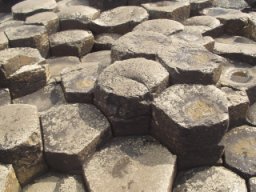Giant's Causeway
The Giant's Causeway is a area of 40,000 tightly packed basalt columns resulting from a volcanic eruption 60 million years ago. The tops of the columns form stepping stones that lead from the cliff foot and disappear under the sea. Most of the columns are hexagonal, however there are some with four, five, seven and eight sides. The tallest are about 40 feet high, and the solidified lava in the cliffs is 90 feet thick in places. It is a World Heritage Site in Ireland and is located on the North Antrim Coast of Northern Ireland.
While recent scientific research1 suggests the columns were formed as a natural consequence of lava cooling, legend has it that the giant Finn MacCumhaill (Finn McCool) built the causeway to walk to Scotland without having to get his feet wet.
References
1 Jagla, E. A., Rojo, A. G. Sequential fragmentation: the origin of columnar quasihexagonal patterns. Physical Review E, 65, 026203, (2002) [1]



